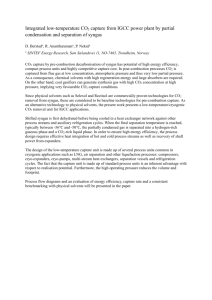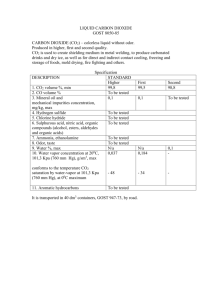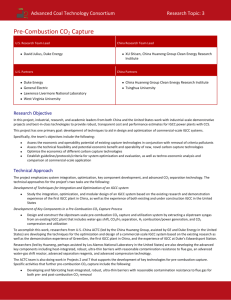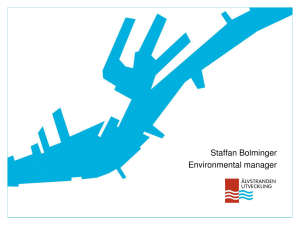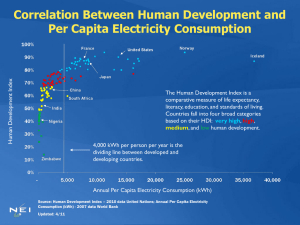CO2_Cost_David
advertisement
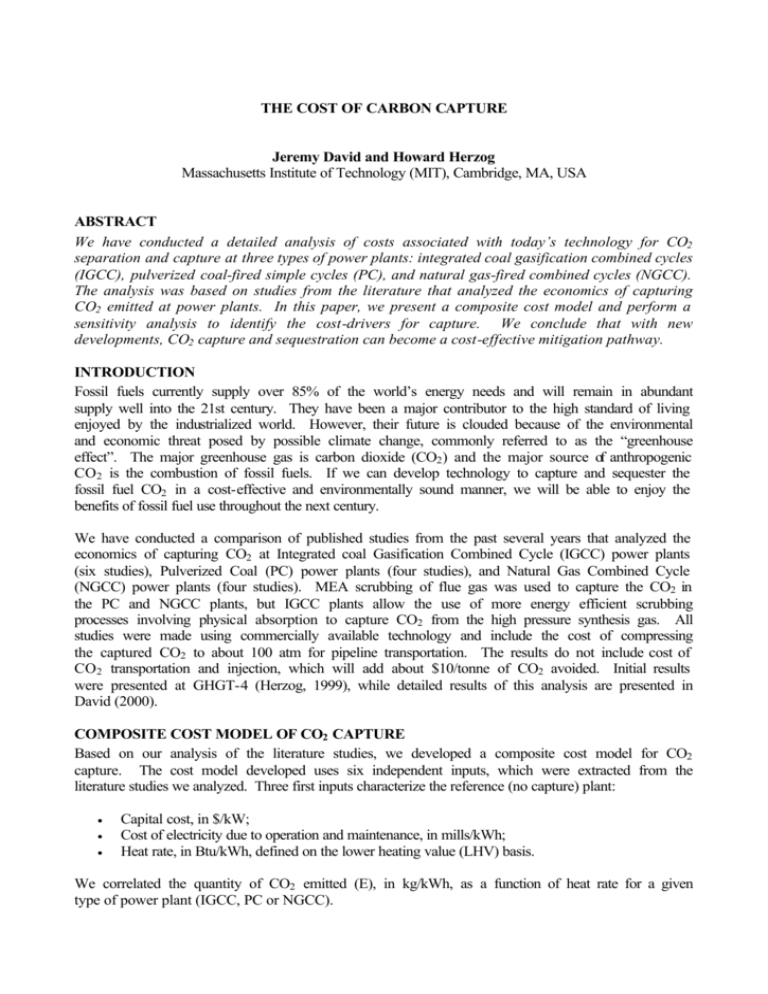
THE COST OF CARBON CAPTURE Jeremy David and Howard Herzog Massachusetts Institute of Technology (MIT), Cambridge, MA, USA ABSTRACT We have conducted a detailed analysis of costs associated with today’s technology for CO2 separation and capture at three types of power plants: integrated coal gasification combined cycles (IGCC), pulverized coal-fired simple cycles (PC), and natural gas-fired combined cycles (NGCC). The analysis was based on studies from the literature that analyzed the economics of capturing CO2 emitted at power plants. In this paper, we present a composite cost model and perform a sensitivity analysis to identify the cost-drivers for capture. We conclude that with new developments, CO2 capture and sequestration can become a cost-effective mitigation pathway. INTRODUCTION Fossil fuels currently supply over 85% of the world’s energy needs and will remain in abundant supply well into the 21st century. They have been a major contributor to the high standard of living enjoyed by the industrialized world. However, their future is clouded because of the environmental and economic threat posed by possible climate change, commonly referred to as the “greenhouse effect”. The major greenhouse gas is carbon dioxide (CO2 ) and the major source of anthropogenic CO2 is the combustion of fossil fuels. If we can develop technology to capture and sequester the fossil fuel CO2 in a cost-effective and environmentally sound manner, we will be able to enjoy the benefits of fossil fuel use throughout the next century. We have conducted a comparison of published studies from the past several years that analyzed the economics of capturing CO2 at Integrated coal Gasification Combined Cycle (IGCC) power plants (six studies), Pulverized Coal (PC) power plants (four studies), and Natural Gas Combined Cycle (NGCC) power plants (four studies). MEA scrubbing of flue gas was used to capture the CO2 in the PC and NGCC plants, but IGCC plants allow the use of more energy efficient scrubbing processes involving physical absorption to capture CO2 from the high pressure synthesis gas. All studies were made using commercially available technology and include the cost of compressing the captured CO2 to about 100 atm for pipeline transportation. The results do not include cost of CO2 transportation and injection, which will add about $10/tonne of CO2 avoided. Initial results were presented at GHGT-4 (Herzog, 1999), while detailed results of this analysis are presented in David (2000). COMPOSITE COST MODEL OF CO2 CAPTURE Based on our analysis of the literature studies, we developed a composite cost model for CO2 capture. The cost model developed uses six independent inputs, which were extracted from the literature studies we analyzed. Three first inputs characterize the reference (no capture) plant: • • • Capital cost, in $/kW; Cost of electricity due to operation and maintenance, in mills/kWh; Heat rate, in Btu/kWh, defined on the lower heating value (LHV) basis. We correlated the quantity of CO2 emitted (E), in kg/kWh, as a function of heat rate for a given type of power plant (IGCC, PC or NGCC). The second three inputs characterize the capture plant: • • • Incremental capital cost, in $/kg of CO2 processed per hour; Incremental cost of electricity due to operation and maintenance, in mills/kg of CO2 processed; Energy requirements of the capture process, in kWh/kg of CO2 processed. The capture efficiency is usually about 90% in the studies reviewed. To compare the different types of capture plants on a similar basis, the capture efficiency needs to be kept constant. Consequently, we set the capture efficiency at a constant value of 90%. The symmetry of the cost model inputs is shown in Table 1. The generation costs are normalized by the reference power plant output, while the capture costs are normalized by the quantity of CO2 processed (which is directly related to the quantity and type of fuel burnt at the plant). These six parameters can be reasonably viewed as independent of each other. The inputs from the literature studies we analyzed are averaged for each type of power plant to obtain the composite cost model inputs shown in Table 2. Table 1: Cost Model Inputs Capital Costs O&M Costs Energy Requirements Reference Plant $/kW mills/kWh Btu/kWh Capture Plant $/(kg of CO2 processed per hour) mills/kg of CO2 processed kWh/kg of CO2 processed It can be seen that NGCC power plants have the highest incremental capital cost and the highest energy requirements for the capture (0.354 kWh/kg of CO2 processed), due to the low content of CO2 in the flue gas (about 3%). Post-combustion decarbonization at PC plants is somewhat less energy intensive than at NGCC plants, 0.317 kWh/kg of CO2 processed, because of the higher content of CO2 in the flue gas (about 13%). Finally, the carbon dioxide is in a concentrated flow under a fairly high pressure at IGCC plants, so these plants have the lowest energy requirements (0.194 kWh/kg of CO2 processed). Table 2 reports the costs obtained for each type of power generation. We found that carbon dioxide capture increases the busbar electricity cost (COE) from 5.0 to 6.7 ¢/kWh at IGCC plants, from 4.4 to 7.7 ¢/kWh at PC plants, and, finally, from 3.3 to 4.9 ¢/kWh at NGCC plants. Today, reference PC plants are slightly less expensive than reference IGCC plants. However, IGCC plants will become more economical than PC plants if carbon sequestration becomes necessary. Natural gas is always more competitive than coal for both reference and capture plants, assuming today’s fuel prices remain constant. If gas prices rise relative to coal in the future, IGCC capture plants could then compete with NGCC capture plants. Table 2: Cost Model for Capture Plants, in 2000 and 2012 Cycle Data Description Input Capital Cost, $/kW O&M, mills/kWh Heat Rate (LHV), Btu/kWh Incremental Capital Cost, $/(kg/h) Incremental O&M, mills/kg Energy Requirements, kWh/kg Basis Yearly Operating Hours, hrs/yr Capital Charge Rate, %/yr Fuel Cost (LHV), $/MMBtu Capture Efficiency, % Reference Plant CO2 Emitted, kg/kWh coe: CAPITAL, mills/kWh coe: FUEL, mills/kWh coe: O&M, mills/kWh Cost of Electricity, ¢/kWh Thermal Efficiency (LHV), % Capture Plant Relative Power Output, % Heat Rate (LHV), Btu/kWh Capital Cost, $/kW CO2 Emitted, kg/kWh coe: CAPITAL, mills/kWh coe: FUEL, mills/kWh coe: O&M, mills/kWh Cost of Electricity, ¢/kWh Thermal Efficiency (LHV), % Comparison Incremental coe, ¢/kWh Energy Penalty, % Mitigation Cost, Capture vs. Ref., $/tonne of CO2 avoided IGCC 2000 IGCC 2012 PC 2000 PC 2012 NGCC 2000 NGCC 2012 1401 7.9 8081 305 1145 6.1 7137 275 1150 7.4 8277 529 1095 6.1 8042 476 542 2.5 6201 921 525 2.4 5677 829 2.65 0.194 2.39 0.135 5.56 0.317 5.00 0.196 5.20 0.354 4.68 0.297 6570 15 1.24 90 6570 15 1.24 90 6570 15 1.24 90 6570 15 1.24 90 6570 15 2.93 90 6570 15 2.93 90 0.752 32.0 10.0 7.9 4.99 42.2 0.664 26.1 8.8 6.1 4.10 47.8 0.789 26.3 10.3 7.4 4.39 41.2 0.766 25.0 10.0 6.1 4.10 42.4 0.368 12.4 18.2 2.5 3.30 55.0 0.337 12.0 16.6 2.4 3.10 60.1 85.4 9462 1909 0.088 43.6 11.7 11.6 6.69 36.1 91.0 7843 1459 0.073 33.3 9.7 8.4 5.14 43.5 75.0 11037 2090 0.105 47.7 13.7 15.7 7.71 30.9 85.0 9461 1718 0.090 39.2 11.7 11.6 6.26 36.1 87.0 7131 1013 0.042 23.1 20.9 5.1 4.91 47.8 90.0 6308 894 0.037 20.4 18.5 4.4 4.33 54.1 1.70 14.6 1.04 9.0 3.32 25.0 2.16 15.0 1.61 13.0 1.23 10.0 26 18 49 32 49 41 The mitigation cost (MC) in $/tonne CO2 avoided is given by the following equation: MC = COE cap − COE ref (1) Eref − Ecap The mitigation cost can be calculated by comparing a capture plant to any reference plant (e.g., capture IGCC vs. reference IGCC, PC or NGCC). Fig. 1 plots the cost of electricity vs. CO2 emissions of the three reference plants and of an IGCC capture plant. The mitigation cost, which is simply the slope of the connecting lines shown on Fig. 1, varies depending on the reference plant chosen for the base case: IGCC ($26 per tonne of CO2 avoided), PC ($33 per tonne of CO2 avoided), and NGCC ($121 per tonne of CO2 avoided). Furthermore, the y-intercept of each line gives the cost of electricity that a zero emission technology must beat to be competitive with the IGCC sequestration option (7.76 cents per kWh based on a NGCC reference plant). It can be argued that NGCC plants should be the basis because they are the most popular plants being built today. This yields mitigation costs of $121 per tonne of CO2 avoided for a capture IGCC plant, $168 per tonne of CO2 avoided for a capture PC plant and $49 per tonne of CO2 avoided for a capture NGCC plant. Electricity Cost (¢/kWh) 8 7 6 IGCC - ref. PC - ref. NGCC - ref. IGCC - cap. 5 4 3 0.0 0.2 0.4 0.6 0.8 1.0 CO2 Emissions (kg/kWh) Figure 1: Calculating Mitigation Costs IDENTIFICATION OF COST-DRIVERS AND FUTURE ECONOMICS The six inputs of the cost model (see Table 2, year 2000 plants) are treated as independent variables. A sensitivity analysis (i.e., the inputs are decreased by 10% one by one for each type of power plant) is performed to identify the key inputs affecting the economics of the capture. Figures 2 and 3 show the change in incremental cost of electricity and mitigation cost at IGCC, PC, and NGCC power plants for a 10% decrease in each input. Note that a 10% decrease in heat rate is equivalent to an 11.1% increase in efficiency. Observations that can be drawn from Figs. 2 and 3 include: • • The key cost drivers are heat rate, energy required for capture, and capital costs of capture. Improving heat rates is extremely important for improving the economics of carbon sequestration. This supports a mitigation strategy that focuses on improved efficiency in the near-term, with sequestration becoming more important in the longer-term. Capital Cost O&M IGCC Heat Rate PC Inc. Capital Cost NGCC Inc. O&M ER 0% 2% 4% 6% 8% 10% 12% 14% Figure 2: Incremental cost of electricity sensitivity to the cost model inputs. Decrease in incremental cost of electricity for a 10% decrease in each of the six inputs. Capital Cost O&M IGCC Heat Rate PC Inc. Capital Cost NGCC Inc O&M ER 0% 2% 4% 6% 8% 10% 12% 14% Figure 3: Mitigation cost sensitivity to the cost model inputs. Decrease in mitigation cost for a decrease in each of the six inputs.. FUTURE ECONOMICS Technological improvements in power generation and capture technology can lower the capture costs. For instance, capital investment can be lowered and efficiency increased at the reference plant. Moreover, it is likely that improved solvents and system components will reduce the capital and energy costs for synthesis gas or flue gas treatment to separate and capture CO2 . The capture costs in 2012 can be predicted by using the cost model. The 2012 capital costs, costs of operation and maintenance, and heat rates are taken from CURC (1998). Reductions in capital cost and gains in heat rate are significant at IGCC plants (above 10%), but limited at PC and NGCC plants (under 10%), which are more mature. The energy requirements are obtained by using the energy penalties given by Herzog and Drake (1993) at IGCC power plants, and by Mimura et al. (1997) at PC and NGCC power plants. The highest reductions in energy requirements for the capture processes are predicted to be at IGCC and PC plants (above 30%). Finally, it is assumed that the incremental capital cost, and the incremental cost of electricity due to operation and maintenance will be lowered by 10% from their 2000 level. Table 2 gathers the economic performance of CO2 capture at IGCC, PC and NGCC power plants in 2012. Although the capture costs are expected to decrease more at IGCC and PC plants than at NGCC plants, the overall economics are still more favorable at NGCC plants. New technologies like coal gasification show the most long-term promise, with incremental costs for CO2 sequestration at IGCC power plants being potentially reduced to about 1¢/kWh in the next decade. CONCLUSION Based on the studies analyzed, there is a consensus that using today’s capture technology would add 1.5-2¢/kWh to the busbar cost of electricity for an IGCC or NGCC power plant. For a PC plant, the incremental cost of electricity would be over 3¢/kWh. The strongest opportunities for lowering the capture costs in the future were identified as gains in heat rates and reductions in the amount of energy required by the separation. New technologies like coal gasification show the most long-term promise, with incremental costs for CO2 sequestration at IGCC power plants being potentially reduced to about 1¢/kWh in the next decade. To put the costs presented here in context, further analysis with economic models is required (see Biggs et al., 2000). Opportunities for future cost reductions will include the investigation of innovative technologies, including new types of power plants and power cycles. Moreover, system-level analyses should be performed to minimize not only capture costs, but also the sequestration costs associated with transportation and injection. REFERENCES CURC (Coal Utilization Research Council), Incentives and Research & Development for Early Commercial Applications of Clean Coal Technology (November 1998). Biggs S, H Herzog, H Jacoby and J Reilly, “Economic Modeling of CO2 Capture and Sequestration,” these proceedings (2000). David J, “Economic Evaluation of Leading Technology Options for Sequestration of Carbon Dioxide,” M.S. Thesis, Technology and Policy Program, MIT, Cambridge, MA (2000). Available at: <http://web.mit.edu/sequestration/JeremyDavid.pdf> Herzog H and E Drake, “Long-Term Advanced CO2 Capture Options,” Cheltenham, U.K.: IEA/93/0E6; IEA Greenhouse Gas R&D Programme (1993). Herzog H, “The Economics of CO2 Capture,” P Reimer, B Eliasson, A Wokaum, eds., Greenhouse Gas Control Technologies, Oxford: Elsevier Science Ltd., pp. 101-106 (1999). Mimura T, H Simayoshi, T Suda, M Iijima and S Mituoka, “Development of Energy Saving Technology for Flue Gas Carbon Dioxide Recovery by Chemical Absorption Method and Steam System in Power Plant,” Energy Convers. Mgmt. Vol. 38, Suppl., pp. S57-S62 (1997). ACKNOWLEDGEMENTS This work was conducted with support from the U.S. Department of Energy under award number DE-FG02-99ER62748. We gratefully acknowledge this support, as well as the encouragement of the program managers, John Houghton (BER program, Office of Science) and Bob Kane (Office of Fossil Energy).
